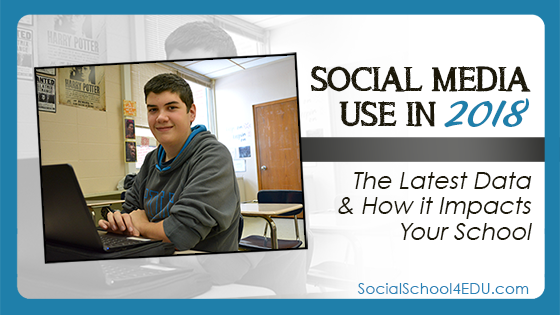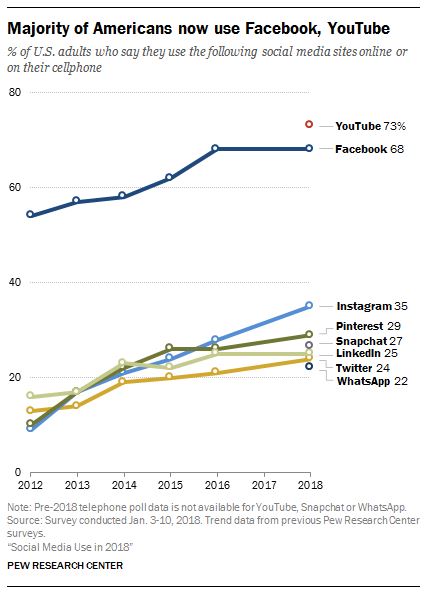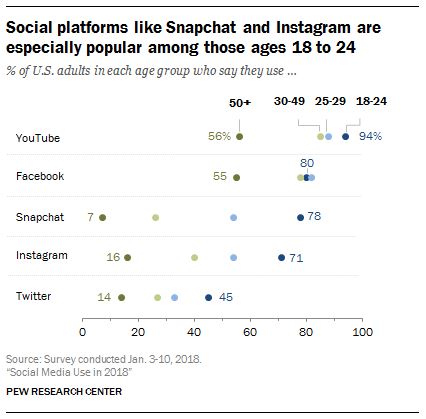Are you having a tough time keeping up with social media for your school?
I think we all feel overwhelmed from time to time. It might be advantageous to take a moment to rethink your social strategy.
Should you launch a new platform?
Or even cut some channels out?
Well, the most effective way to make that decision is to base it on data.
And boy, are you in luck! There is new data that just came out which shows how Americans are using social media. Let’s look at a quick overview of the data and then discuss how it impacts your school.
In an article dated March 1, 2018, a Pew Research Center study broke out that outlines the latest trends in social media use.
Roughly two-thirds of U.S. adults are using Facebook, and roughly three-quarters of those users access Facebook on a daily basis.YouTube is even higher, but you might realize that this social channel is a bit different than other platforms. Many users simply use it to consume video, not necessarily their own share videos on it.
It’s a long way to third place, but it’s important to note that channel.
Instagram.
More than one-third of adults are using Instagram. This is much higher than the 24% who are using Twitter.
The research breaks down their data even further to identify another age bracket.
The study looked specifically at 18 to 24-year-olds; this is both the lowest age bracket that they have and the one that would match the social media use of your students.
The top four channels for this age demographic are YouTube, Facebook (yes – they still use Facebook), Snapchat, and Instagram.
What This Means For Your School
Facebook:

This new data continues to support my endorsement that Facebook is the number one channel for your school. If you are not using fully utilizing Facebook, then I would stop and focus all of your attention on getting that platform up to speed.
So what does “fully utilizing Facebook” look like for a school? Your page likes should match your enrollment, and continue to grow at a rate of 25% each year. You should be posting one to three times per day and your weekly organic reach should be about four times your page likes.
If you need help in getting the foundational steps right, there is a recorded webinar on this topic that can be accessed by members only. If you are interested in joining us, learn more here.
YouTube:

YouTube is an obvious platform for your social media presence, but of course, that will consist of only video content. YouTube has really changed over the last several years, introducing enhanced features. Did you know that you can easily livestream from your YouTube channel with a couple of clicks? Check it out!
Now, I know that some schools stay away from YouTube because the platform allows for little control over advertisements and other content that can show up after a video is watched. I get it – and you need to make the best decision for your school.
Instagram:

If reaching students and young parents is important to your school, then Instagram is a must-have. The best news is that Instagram is highly visual and is so easy to start!
This short blog article shows you How to Start an Instagram Page. There is also a recorded webinar on this topic that can be accessed by members only. If you are interested in joining us, learn more here.
Instagram stories, student takeovers, Instagram Live – the opportunities are plentiful on this platform. But don’t get overwhelmed. Start posting a few times a week, always use your school hashtag, and you’ll learn more as you go.
Twitter:

I love Twitter. It is such a powerful professional development tool for me. But for schools using social media to connect to their community, it might not be the best use of your time.
This is simply based on the data above. If you have been using Twitter for a few years and have just a few hundred followers, it might be time to eliminate this channel from your school’s social media strategy.
Snapchat:

If you’re using Snapchat well for your school, then I want to hear about it! There are only a handful of K-12 schools that I have heard of that seem to be using this efficiently for their district.
Why?
It’s where kids go to hang out AWAY from school and adults and supervision…
While I know it can be used to help your school, I just don’t know if the time investment to learn how to use it to its fullest capacity is worth it. There is a recorded webinar on this topic that can be accessed by members only. If you are interested in joining us, learn more here.
But Wait: My School is Different
Your community’s use of social media may not match this latest research. If you have a strong following on Twitter, then of course you will continue focusing on that!
The best way to get an honest assessment of your community is to ask them. You could create a very simple survey (Google Form or Survey Monkey) that asks what social media platforms they use and how often they use them. Asking participants to select an age category is a must for this survey.
It’s important to get this survey out to your community in more ways than just sharing it on social media! Obviously, if you promote the survey on your district’s Facebook page, and those are the people who respond to the survey, the data will be strongly biased by those respondents. You may want to plan a survey during back-to-school time where every student and parent is asked which social channels they use.
What’s Next?
Will there be a new social media platform popping up that may impact your school?
It’s very likely.
I think the best way to stay informed on these trends is to keep in contact with other #SchoolPR professionals from across the country.




